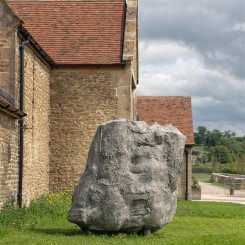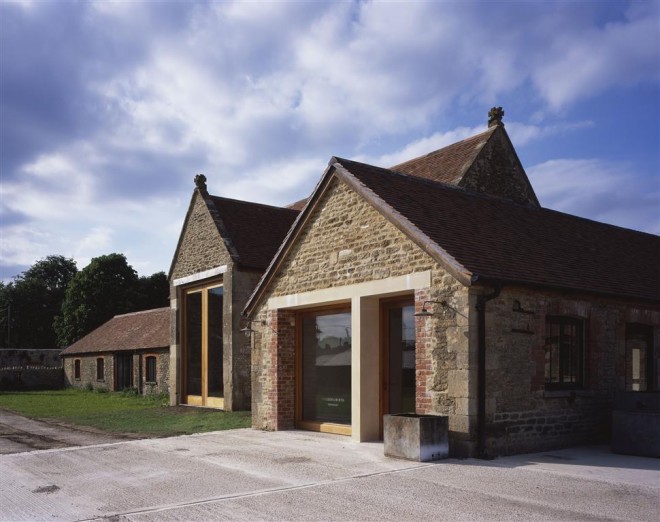The usual summer lull affecting the art world didn’t apply this year in rural England. That contemporary art has landed firmly in the old market town of Bruton in Somerset (about 2 hours’ drive southwest from London) does not come as a huge surprise; preceding it are the likes of fashion and film as rich, privileged, creative types up sticks from London to seek solace and crumbling stone in the English countryside. The fashion designer Phoebe Philo is there, as is the artist/filmmaker Sam Taylor-Wood; Madonna and Guy Ritchie used to live not far away, and Sting’s mansion is in a neighbouring county. Band-members and models are amongst those chasing organic fare and cider in the area—not least after British Vogue devoted seven pages to Bruton in its August issue.(1) “Right now there’s no place like home,” declared Conde Nast Traveller under “Destinations to Watch” this year.(2)
For one, the ex-Notting Hill restaurateur Catherine Butler and her husband Ahmed Sidki, a furniture designer, opened At The Chapel in the high street in 2008. This hotel-cum-bakery and restaurant is now all the rage, and is generally seen as having kicked off the move towards Somerset. Bruton “reminds me of Notting Hill in the early days”, Butler told The Times newspaper. (3)
And so to contemporary art. Iwan and Manuela Wirth, the married team behind international gallery Hauser and Wirth (branches in New York, London and Zurich), have lived in Bruton with their children since 2007. In 2009, they purchased a dilapidated farmhouse with land and outbuildings on the outskirts of the town. “Hauser and Wirth Somerset,” as it is now known, opened in mid-July.
“We loved what we saw. And then this project fell in our lap,” Iwan Wirth told the FT about finding Durslade Farm (4), a characterful 18th-Century property built from light brown local stone. After years of work, and surely a huge investment, the farm now incorporates five gallery spaces of varying size (from a sequence of low, pitched-roofed rooms to a large barn and a single “white cube”-style space that would befit a large London gallery), covering a total area of 2,483 sqm. These galleries sit around a central courtyard, and retain names attached to their former uses—the Threshing Barn, the Cart Shed, the Workshop, the Pigsty.
Open six days a week with free admission, they will be host to a program of major solo and group exhibitions the first of which, currently on display, are “GIG”, a robust, memorable show by the British artist and Royal Academician Phyllida Barlow and “Open Field”, a retrospective and outdoor installation by Piet Oudolf, who most famously designed the landscaping and planting for the High Line redevelopment in New York. His floral concept for the meadow at Durslade Farm will open to the public in September this year. In addition, the farm site is peppered with large outdoor sculptures by artists including Subodh Gupta, Paul McCarthy, Martin Creed (a giant white neon work pinned to the farmhouse reads “EVERYTHING IS GOING TO BE ALRIGHT”) and Louise Bourgeois (the indefatigable “Spider” sculpture of 1994).
But this is not all. In the sort of PR-friendly community spirit that is the darling of contemporary British politics and which helps make the cultural and tourism industry the fastest growing sector in areas like Somerset, Hauser and Wirth’s activities extend to numerous outreach and education programs. To quote the Somerset gallery director Alice Workman: “Hauser & Wirth Somerset is committed to the local community and supports, collaborates and works in partnership with many local institutions, businesses and organizations. Its founders Iwan and Manuela Wirth live locally and are patrons of a number of charities.” The gallery hopes to engage different audiences with “a subsidised education programme, a garden, restaurant and extensive events programme, as well as talks and seminars about topics that are not directly related to the art world like gardening, food and the countryside.”
Showing rather more charisma, Iwan Wirth is enraptured about the project. “To live where you work, eat what you grow and share it with your friends: How much better can it get?” he asked the FT.(6) He calls the project “a joint effort,” describing the involvement of American artist Roni Horn, for example, in the architectural re-design of the farm buildings (“She removed the window from one of the spaces, which was a key change”)(7).
Adjacent to the entrance area with its book and souvenir shop, The Roth Bar & Grill at Durslade is run by Catherine Butler from At The Chapel. The bar is itself a site-specific art installation made by the son and grandson of Dieter Roth. Punters can gaze upon works by Berlinde de Bruckere, Henry Moore and the late Jason Rhoades while grazing on organic meat produced by Durslade farm, home-made cakes, smoothies and the like. The butter is churned on site, and we are told the restaurant is booked out a week in advance every Friday night. On the menu at Durslade, then, is an unusual marriage proposal between titan art dealers (heavily entwined with a voracious international art world circuit) and a distinctly non-urban, hands-on local environment (albeit now host also to a posse of celebrities). It is a privileged union, but one that it is difficult to be cynical about. The estimated footfall for the site is 40,000 visitors per year.(5)
The next solo exhibition at the farm will be by the Swiss artist Pipilotti Rist whose witty, colorful, sensual, wheeling videos, often focused on plants and bodies, are the perfect choice. The artist spent a year working in Bruton where the gallery also has residency space. “We’ve had three residencies already that have all been quite different,” says Workman, “Pililotti Rist came from Switzerland with her son, who went to the local primary school. Then we had Guillermo Kuitca, who worked at the farm for five weeks in Summer 2013 with a very specific purpose to paint the dining room in the farmhouse as an installation piece. When he left, he said he had had more energy while working here than he had for years.” The idea is for artists to benefit from the rural surroundings and involve themselves with the local community, though Workman emphasises that “The residencies do not have any prescribed outcomes”. The British artist Mark Wallinger has just begun a residency there.
Thus is a more comprehensive occupation of this rural hangout by Hauser and Wirth difficult to imagine. It is difficult also not to look forward to one’s next visit to this exuberant new spot. The Durslade farm site is both inviting and sophisticated, ostensibly combining rustic character with mature artistic content and efforts towards audience engagement. It marks a valid—though not entirely novel—step for contemporary art display and experience in the UK.
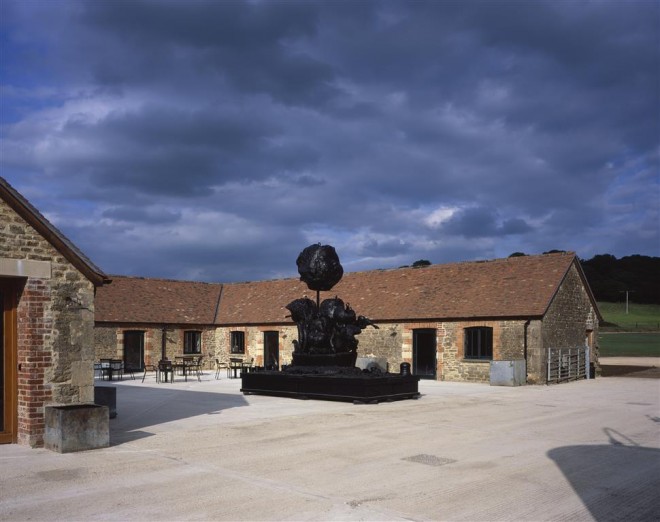
Hauser & Wirth Somerset. Centre: Paul McCarthy, “Ship Adrift, Ship of Fools”, 2010 – 2011 Courtesy Hauser & Wirth. Photo: Hélène Binet.

Phyllida Barlow, “Untitled, Blockcratewedge”, 2014. Installation view in the exhibition “Phyllida Barlow. GIG”, Hauser & Wirth Somerset, 2014. © Phyllida Barlow. Courtesy the artist and Hauser & Wirth. Photo: Alex Delfanne.
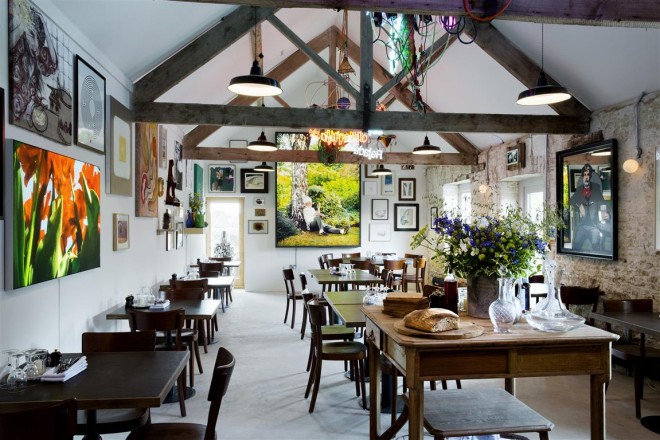
Roth Bar & Grill, Hauser & Wirth Somerset. Courtesy the artists and Hauser & Wirth. Photo: Aaron Schuman.
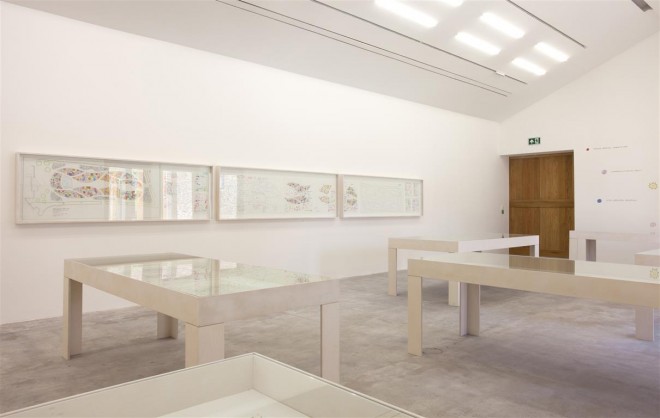
“Piet Oudolf. Open Field”, installation view, Hauser & Wirth Somerset, 2014.
© Piet Oudolf. Courtesy the artist and Hauser & Wirth. Photo: Jamie Woodley
(1) British Vogue, August 2014 Edition.
(2) “Top Ten Destinations to Watch in 2014”, Conde Nast Traveller, no date, accessed August 25, 2014, http://www.cntraveller.com/recommended/itineraries/destinations-to-watch-2014/page/destinations-to-watch-in-2014
(3) Damian Whitworth, “Bruton? It’s like Notting Hill in the early days”, The Times, August 4, 2014, accessed August 25, 2014 http://www.thetimes.co.uk/tto/life/article4164510.ece
(4) Griselda Murray Brown, “Art Gallery Hauser and Wirth sets up a Space in a Somerset Farm”, Financial Times, June 13, 2014, accessed August 25, 2014, http://www.ft.com/cms/s/2/2a803648-ed77-11e3-8a1e-00144feabdc0.html#axzz3BTXhuAyR
(5) Sally Shalam, “Hauser and Wirth Somerset…the next Guggenheim?”, The Guardian, March 21, 2014, accessed 25 August, 2014, http://www.theguardian.com/travel/2014/mar/21/hauser-and-wirth-somerset-art-gallery-next-guggenheim
(6) Griselda Murray Brown, “Art Gallery Hauser and Wirth sets up a Space in a Somerset Farm”, Financial Times.
(7) Idem.

